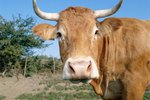
The name "clam" is a generic term for a range of different two-shelled mollusk species, also known as bivalves. Though they don't look much like living creatures at first glance, they have circulatory systems, hearts and other internal organs, and can move around using muscular organs, known as feet, that can be pushed out from between their shells. The world's largest species is the giant clam, which can reach up to 4 feet long.
Filter Feeding
Clams are known as filter feeders because of the way they eat their food. Since they have no heads or biting mouthparts, they have to feed in an unusual way. They pull water -- which also contains food particles -- in through one of their syphons and into their gills. The cilia in the clams' gills is able to trap the tiny food particles from the water and move them down to their mouth, where they can be eaten and digested. The water is then pushed out through the other syphon.
References
Photo Credits
-
Comstock/Stockbyte/Getty Images



